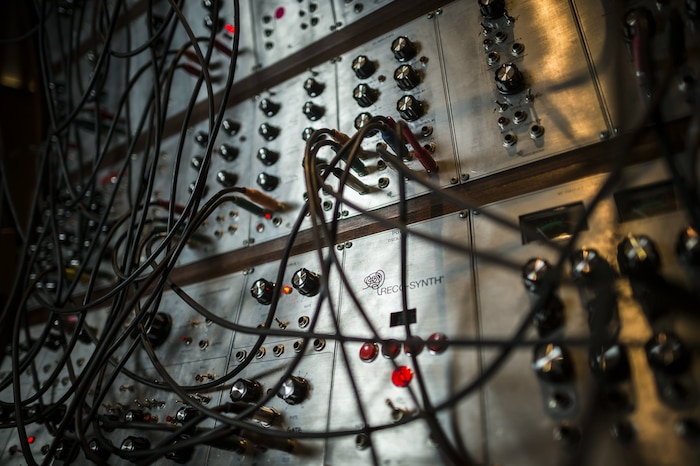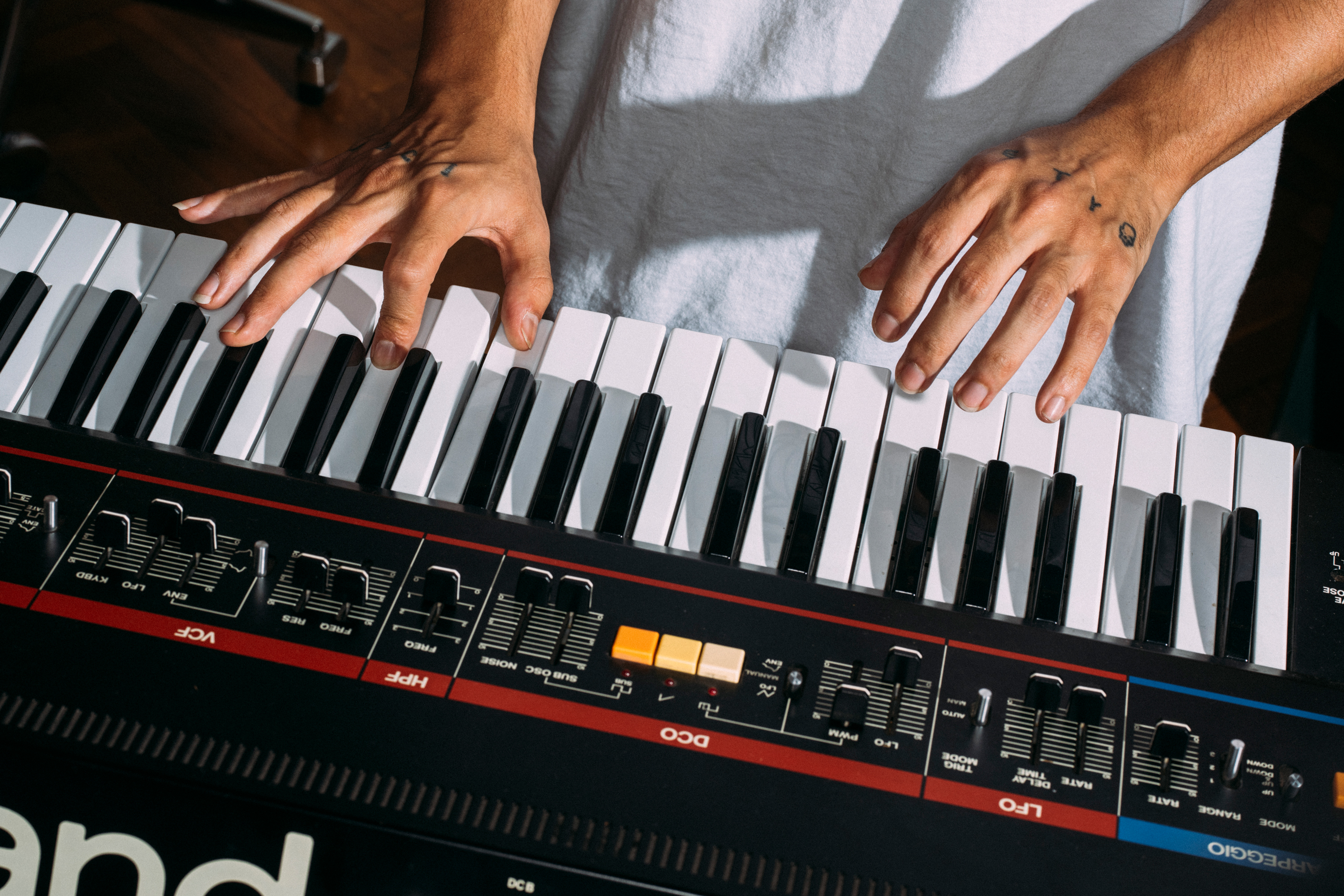Speaking In Synth
Phil Moffa breaks down some key synthesizer terminology to coincide with RBMA’s First Patch series

Synthesizers can be intimidating. Depending on the synth, it’s not always easy to figure out where to begin between the various inputs, wires and knobs. Our series First Patch, hosted by former Korg head engineer Tatsuya Takahashi, is dedicated to addressing this pain point by providing essential instruction needed to start making electronic music in five minutes or less. To accompany the series, we asked engineer, producer, studio owner and all-around audio expert Phil Moffa to put together a brief guide to synthesizer terminology. It’s not quite a full A-Z, but this breakdown should ensure that almost no abbreviation or reference will pass you by when you finally sit down with these machines.
Watch all episodes from the first season of First Patch here.
2-Pole/4-Pole
These terms – and the numbers can also be three, eight, or whatever a manufacturer decides – deal with the the severity of a filter’s cutoff. Each “pole” refers to a six decibel-per octave roll off at the cutoff frequency. The higher the number, the more severe the cutoff slope and how apparent the filter will be.
Additive Synthesis
A less common type of synthesis, and usually only possible with computers or a great deal of hardware oscillators, additive synthesis is the combination of several sine waves to modulate each other and create new timbres. Naturally, overlapping sine waves at different frequencies beat, or cancel each other out. Doing this with lots of oscillators can create unique and interesting sounds.
ADSR (Attack/Decay/Sustain/Release)
These are four stages of an envelope. When talking about the amplitude or volume of a patch, a fast attack time means that the sound kicks in immediately and is percussive, while a slow attack time fades in, like a bowed-type sound. The decay stage is next, and determines how loud something is while it approaches the sustain, which is how loud something is while a key is being held. The release begins when a note is let go of. A fast release time will turn a sound off quickly, while a long release time will take some time to fade out before the next note is pressed. This same example is commonly applied to a filter cutoff position. In modern synthesizers, an envelope can be applied to almost any parameter.
Arpeggiator
The Italian term “arpeggio” refers to playing the notes of a chord in succession, either ascending or descending. An arpeggiator therefore is a type of pattern sequencer that plays notes rhythmically, based on keys that are held down. In some synths the rhythm is basic 8th or 16th-note values, and in others there are more complex patterns, alternating octaves, rests and other features. Normally there is a button to “hold” an arpeggio, which as a bonus frees up the hands for tweaking additional parameters.
Cutoff
The frequency position of a filter. As the cutoff is lowered on a lowpass filter, high frequencies are removed and a sound becomes darker. As the cutoff is raised on a highpass filter, low frequencies are removed and a sound becomes thinner.
Cycle / Frequency / Pitch
When discussing sound, a single vibration, which can be viewed in digital audio as one positive and negative waveform across the zero line, is known as a “cycle.” “Frequency” refers to how many cycles occur in a second of time. This is measured in Hertz. For example, the A above middle C on a piano is normally tuned to a frequency of 440 Hz, meaning the string moves back and forth 440 times in a single second. “Pitch” is a term that describes how a frequency is perceived by the human ear, determined to be higher or lower than other pitches, assigned a note name and placed into scales.
Filter
In subtractive synthesis, a filter removes frequencies to modify a timbre. Common filter types are lowpass, highpass and bandpass. These are often mixed up, but can be remembered this way: A lowpass let’s the lows pass, meaning that the highs are cut out. It makes the sound darker. Obviously, the highpass is the opposite – by letting the highs pass, it makes a sound thinner. A bandpass removes from both ends of the spectrum and is useful for making sounds fit into a particular place.
LFO (Low Frequency Oscillator)
Generally a modulator, or something that is not heard but used to rhythmically manipulate a parameter such as oscillator tuning (vibrato), volume (tremolo) or filter position. In more modern synthesizers, several LFOs are available and almost any parameter can be modulated, even the speed of other LFOs. LFO speed is commonly called “rate” and the amount of modulation it causes is usually called its “depth.” LFOs also have a shape, similar to audible oscillators, that determines their movement.
MIDI
This stands for “Musical Instrument Digital Interface” and is a standard language that allows electronic instruments, computers and other devices to communicate. Notes, velocity, pitch bend, mod wheel, tempo (as beat clock) and many other messages are capable of being sent as digital information through MIDI and USB cables, and, more recently, wirelessly.
Monophonic/Duophonic/Polyphonic/Paraphonic
A monophonic synth is only capable of producing one note at a time, like the iconic Minimoog or MS-20 synthesizers. A polyphonic synth can produce multiple notes or chords, and the amount of notes possible at one time is referred to as a synth’s “polyphony.” For example, a Juno 106 has six-note polyphony.
A duophonic synth like the ARP Odyssey is capable of producing two notes at once. Some synths have a unison mode which makes them monophonic by playing several voices at once for a fatter sound, at the price of losing polyphony. Oscillators on a paraphonic synth can play different notes, but they share the same VCF and VCA, which gives them different articulations than polyphonic synths.
Multi-Timbral
A synthesizer that can only produce one patch at a time, regardless of its polyphony, is not multitimbral. A multi-timbral synth therefore can receive MIDI note messages on different channels and produce many different patches at once. For example, on channel one there can be a bass, on two a lead, on three pads and so on. It is then up to the user to mix these internally with patch volume or route the different patches to additional outputs for external mixing.
Oscillator
Imagine a string being bowed. It quickly vibrates back and forth, and we measure its frequency by how many times it oscillates in a second. In a synthesizer, this is accomplished with a circuit (analog) or with a simulation of a circuit (digital). In an analog synth, depending on which key is pressed, a VCO controls the frequency by a voltage input, hence the name “voltage controlled oscillator.” In synths with multiple oscillators, there is often a “sync” button to align their tuning. Slight detuning creates nice phasing effects, while more extreme detuning can create intervals between the oscillators.
Portamento
This feature enables notes to slide into one another, and sometimes it is labeled “slide” or “glide” instead. There is usually a switch for turning portamento on, and then an amount which determines the speed of the transition between notes. Listening to lines on a TB-303 will give you a good idea of the sound of slide. The feature is integral to this synth’s sequencer, and slide can be turned on per note, allowing them to bend into the next note in the sequence. It is also commonly used on funky lead or basslines on any mono synth, or to create long rises and falls.
Resonance
The emphasis of the cutoff frequency. The higher the resonance, the more apparent a filter sweep will be. At extreme settings, many filters will self-oscillate and can become a sound source.
Ring Modulator
This can be either a standalone device or part of a synth’s architecture. It is used to create harmonically unique sounds, like bells or other metallic sounds. This is accomplished by modulating two sounds, like a VCO and carrier oscillator, and simultaneously outputting their sum and difference. Often, the end result sounds unrelated to its sources, and notes struck on a keyboard can create pitches that are unpredictable.
Suboscillator
As the name indicates, this oscillator is normally tuned an octave or two below the regular oscillators for more bass impact. These usually have limited parameters compared to standard oscillators.
Subtractive Synthesis
Probably the most common type of synthesis, this gets its name from the way filters subtract frequencies to modify timbres. In subtractive synthesis, sound is typically created by oscillators, then filtered and finally amplified. Along the way, sounds can be modulated by LFOs or envelopes.
Timbre
Refers to a sound’s tone or color. Any instrument can play the same note, but the timbre refers to the overtones or harmonics that identifies what sound is being heard. In a synthesizer, different oscillator waveforms determine timbre.
VCA (Voltage Controlled Amplifier)
Usually last in the path of an analog subtractive synthesizer, this stage is where voltage determines the amount of signal that goes to the output. This is often controlled by its own ADSR envelope to determine the speed at which the sound is introduced, is held and eventually goes away before the next note is triggered.
Velocity
A MIDI message that refers to how hard a note is struck. Most MIDI messages, including velocity, have a range of 0-127.
Waveforms / Waveshapes
Timbre is determined by waveforms. In synthesis, a sine wave is theoretically pure with no overtones, a squarewave utilizes odd harmonics for an identifiable hollow sound (think Atari), a triangle is something in-between sine and square, with half the power of the harmonics of a square, and a sawtooth has rich harmonics, often compared to brass instruments. In many synths, waveforms can be blended for variations on the standard shapes. Blending oscillators with different waveshapes also creates new timbres.

